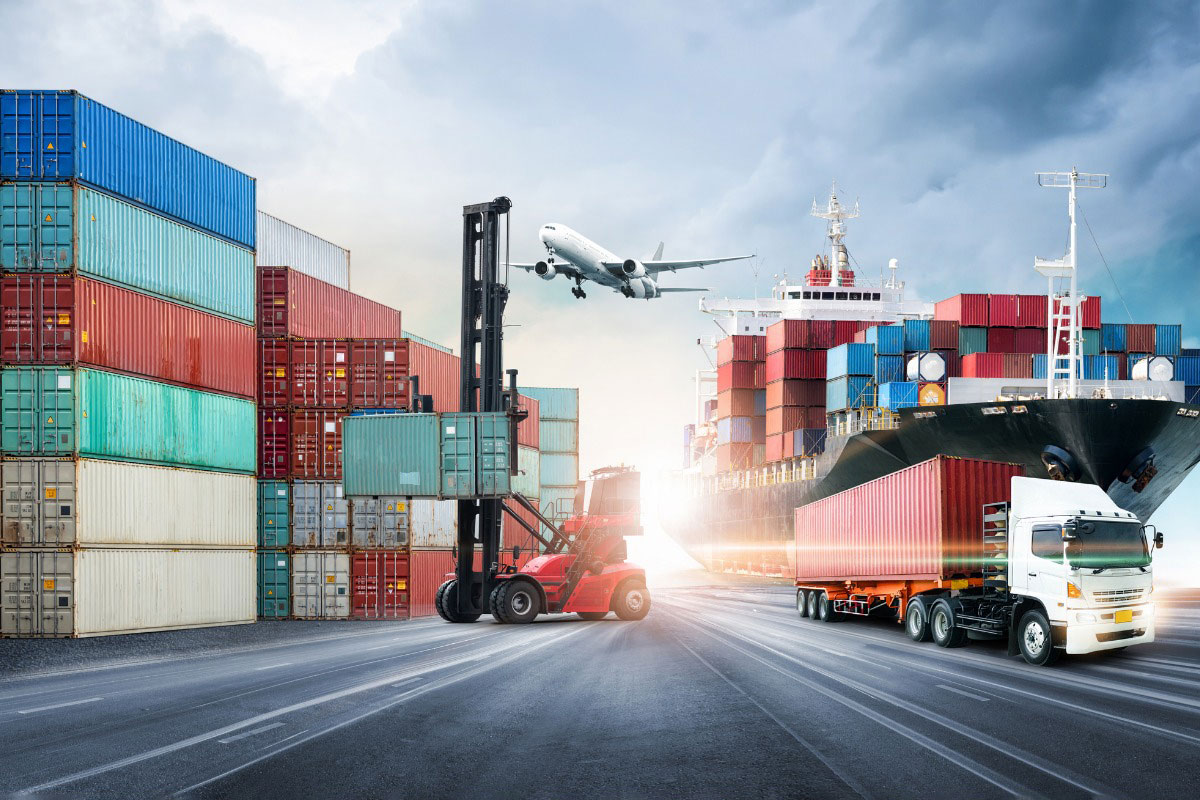

Finance
What Is The Global Supply Chain?
Published: October 19, 2023
Discover the significance of the global supply chain in the world of finance and how it impacts businesses and economies worldwide.
(Many of the links in this article redirect to a specific reviewed product. Your purchase of these products through affiliate links helps to generate commission for LiveWell, at no extra cost. Learn more)
Table of Contents
- Introduction
- Definition of Global Supply Chain
- Key Components of the Global Supply Chain
- Benefits of a Global Supply Chain
- Challenges of a Global Supply Chain
- The Role of Technology in Global Supply Chains
- Importance of Collaboration and Communication in Global Supply Chains
- Risk Management in the Global Supply Chain
- Conclusion
Introduction
The global supply chain is a complex network of organizations, processes, and resources involved in the production and distribution of goods and services worldwide. It spans across multiple countries, continents, and time zones, connecting suppliers, manufacturers, distributors, retailers, and consumers.
In today’s interconnected world, businesses are increasingly expanding their operations beyond domestic boundaries to tap into new markets, access diverse resources, and capitalize on cost efficiencies. This has led to the emergence of global supply chains, which enable companies to source materials, manufacture products, and distribute them on a global scale.
The globalization of supply chains has been driven by various factors, including advancements in transportation and communication technologies, liberalization of trade policies, and the quest for competitive advantages. As a result, companies now have the ability to source raw materials from one country, manufacture components in another, assemble the final product in yet another, and distribute it to customers all around the world.
The global supply chain plays a crucial role in supporting international trade and economic growth, as it facilitates the movement of goods and services across borders. It has become essential for companies to understand and effectively manage their global supply chains in order to stay competitive in today’s global marketplace.
This article will delve deeper into the concept of the global supply chain, exploring its key components, benefits, challenges, the role of technology, the importance of collaboration and communication, and the need for robust risk management.
Definition of Global Supply Chain
The global supply chain is a complex network that encompasses all the activities involved in delivering a product or service to customers on a global scale. It involves the movement of goods, information, and money across multiple countries, involving various stakeholders such as suppliers, manufacturers, distributors, retailers, and end consumers.
At its core, the global supply chain represents the flow of materials, information, and capital from the point of origin to the point of consumption. It encompasses everything from sourcing raw materials, production and assembly, logistics and transportation, inventory management, to the final delivery of products to customers.
One key aspect of the global supply chain is its global reach. Unlike a traditional supply chain that operates within a single domestic market, a global supply chain extends across borders and often involves operations in multiple countries. This global reach allows companies to tap into new markets, access specialized resources, and leverage cost efficiencies.
Furthermore, the global supply chain is characterized by its interconnectivity. Each stage of the supply chain is linked to the other, forming a seamless flow of information and resources. This interconnectedness ensures that all stakeholders in the supply chain work together to deliver products efficiently and meet customer demands.
Additionally, the global supply chain is highly dynamic and subject to various external factors. Changes in government regulations, trade policies, economic conditions, natural disasters, or even geopolitical events can have a significant impact on the global supply chain. Adapting to these changes requires flexibility, resilience, and effective supply chain management strategies.
In summary, the global supply chain represents the extensive network of organizations, processes, and resources involved in the production and distribution of goods and services on a global scale. It is a complex and interconnected system that requires careful planning, coordination, and management to ensure the efficient movement of products and meet the ever-changing demands of the global marketplace.
Key Components of the Global Supply Chain
The global supply chain consists of several key components that work together to ensure the smooth flow of materials, information, and capital across different countries and organizations. Understanding these components is vital for effective supply chain management and optimizing overall performance. Let’s explore the key components of the global supply chain:
- Sourcing and Procurement: This component involves the identification, selection, and acquisition of raw materials, components, or finished products from suppliers located worldwide. Companies must evaluate various factors like quality, price, reliability, and sustainability to make informed sourcing decisions.
- Production and Manufacturing: This component involves the transformation of raw materials and components into finished products. Manufacturing processes can take place in a single location or be dispersed across multiple countries, depending on factors such as cost, labor availability, expertise, and market proximity.
- Logistics and Transportation: This component focuses on the efficient movement of goods from one location to another. It includes activities such as warehousing, inventory management, order processing, and transportation logistics. Companies must optimize transportation routes, choose appropriate modes of transport (e.g., air, sea, road, rail), and manage customs and trade compliance.
- Warehousing and Inventory Management: This component involves the storage and management of goods before they are distributed to customers. Effective warehousing and inventory management practices ensure adequate stock levels, minimize obsolescence, reduce holding costs, and enable timely order fulfillment.
- Distribution and Fulfillment: This component focuses on getting the finished products to the end customers. It includes activities such as order processing, packaging, labeling, and transportation to the final destination. Effective distribution and fulfillment strategies ensure timely delivery and customer satisfaction.
- Information Technology and Systems: This component involves the use of technology and systems to enable visibility, collaboration, and coordination across the global supply chain. It includes technologies like Enterprise Resource Planning (ERP) systems, Supply Chain Management (SCM) software, and data analytics tools to enhance decision-making, optimize processes, and track performance metrics.
- Collaboration and Partnerships: Collaboration is a critical component of a global supply chain. Building strong relationships and partnerships with suppliers, manufacturers, logistics providers, and customers is essential for effective coordination, communication, and sharing of information. Collaborative initiatives like Vendor-Managed Inventory (VMI) and Collaborative Planning, Forecasting, and Replenishment (CPFR) can enhance efficiency and reduce costs.
- Risk Management: Managing risks is an integral part of the global supply chain. Companies must identify potential risks such as supply disruptions, natural disasters, geopolitical events, or demand fluctuations and implement strategies to mitigate these risks. This can include diversifying suppliers, establishing backup plans, and implementing robust risk mitigation strategies.
These key components form the foundation of the global supply chain. Effective management and integration of these components can lead to improved efficiency, reduced costs, enhanced customer satisfaction, and increased competitiveness in the global marketplace.
Benefits of a Global Supply Chain
The implementation of a global supply chain offers several significant benefits for companies looking to expand their operations on a global scale. By leveraging global resources, reaching new markets, and optimizing efficiencies, businesses can gain a competitive edge. Let’s explore some of the key benefits of a global supply chain:
- Access to Diverse Resources: A global supply chain provides companies with the opportunity to access diverse resources globally. This includes raw materials, specialized components, and skilled labor that may not be available domestically. By tapping into these resources, companies can enhance product quality, increase flexibility, and reduce costs.
- Cost Efficiency: A global supply chain allows companies to take advantage of cost efficiencies. By sourcing materials from low-cost regions and leveraging economies of scale in manufacturing, companies can significantly reduce production costs. Additionally, optimizing transportation and logistics networks can help minimize shipping and distribution expenses.
- Market Expansion: With a global supply chain, companies can expand into new markets and reach a larger customer base. By adapting products and services to local preferences and regulations, businesses can tap into international consumer demand and increase revenue potential. Moreover, a geographically diverse supply chain can help mitigate risks associated with fluctuations in specific markets or regions.
- Improved Product Quality: Global sourcing allows companies to access high-quality materials and components from different suppliers worldwide. This can result in improved product quality, which enhances customer satisfaction and brand reputation. Furthermore, collaboration with suppliers across the globe can lead to innovation and the adoption of best practices.
- 24/7 Operations: With a global supply chain, companies can establish operations in different time zones, enabling 24/7 production and support. This leads to faster response times, shorter lead times, and improved customer service. It also allows for better coordination with suppliers and partners in different time zones, ensuring continuous supply chain operations.
- Enhanced Competitive Advantage: Implementing a global supply chain can provide businesses with a competitive advantage in the global marketplace. By streamlining processes, reducing costs, and accelerating time-to-market, companies can outperform competitors. Global supply chain capabilities also allow for faster product innovation and customization, meeting diverse customer demands.
While a global supply chain offers numerous benefits, it is important to note that it also presents challenges. These challenges include logistical complexities, cultural differences, regulatory compliance, and supply chain disruptions. However, with careful planning, effective management, and the utilization of appropriate technologies, the benefits of a global supply chain far outweigh the challenges.
Challenges of a Global Supply Chain
Implementing a global supply chain comes with its fair share of challenges due to the complex nature of operating across different countries, time zones, and cultures. Businesses must be prepared to address these challenges to ensure a smooth and efficient flow of materials, information, and capital. Let’s explore some of the key challenges of a global supply chain:
- Logistical Complexities: Managing logistics becomes increasingly complex in a global supply chain. Coordinating transportation, customs clearance, and documentation across different countries and regions can be challenging. Companies must optimize transportation routes, consider lead times, and address potential bottlenecks to ensure on-time delivery.
- Cultural and Language Differences: Operating in multiple countries means encountering diverse cultures and languages. Communication can become a challenge, leading to misunderstandings and delays. Companies need to foster cross-cultural understanding, facilitate effective communication, and adapt to local customs to foster strong relationships with suppliers and partners.
- Regulatory Compliance: Each country has unique regulations and compliance requirements that need to be met. Companies must stay up-to-date with international trade laws, customs regulations, product standards, and certifications. Failure to comply can lead to delays, penalties, or even the inability to operate in certain markets.
- Supply Chain Disruptions: The global supply chain is susceptible to various disruptions, including natural disasters, political instability, labor disputes, and economic crises. Companies must develop contingency plans, diversify suppliers, and establish robust risk management strategies to mitigate the impact of disruptions.
- Currency Fluctuations and Financial Risks: Operating across different countries means being exposed to currency fluctuations and financial risks. Exchange rate volatility can impact costs and profits, while fluctuating interest rates and credit risks can affect financial stability. Companies must implement effective currency hedging and financial risk management strategies to mitigate these challenges.
- Information Technology Integration: Integrating Information Technology (IT) systems across different locations can be complex. Diverse applications, infrastructure, and communication networks may pose challenges in data synchronization, standardization, and accessibility. Companies need to invest in robust IT infrastructure and ensure seamless integration to enable real-time visibility and efficient information flow.
Addressing these challenges requires careful planning, effective supply chain management, and collaboration with stakeholders. It is vital for companies to continuously monitor and adapt their strategies, stay abreast of global trends, and utilize advanced technologies such as Artificial Intelligence (AI), Internet of Things (IoT), and data analytics to overcome these challenges and build a resilient global supply chain.
The Role of Technology in Global Supply Chains
Technology plays a crucial role in the management and optimization of global supply chains. It has revolutionized the way businesses operate, enabling streamlined processes, enhanced visibility, and improved decision-making. From advanced analytics to real-time tracking, technology solutions are instrumental in addressing the complexities of global supply chains. Let’s explore the key roles technology plays in global supply chains:
- Supply Chain Visibility: Technology provides real-time visibility into global supply chains, allowing companies to track the movement of goods, monitor inventory levels, and gain insights into production and delivery status. This visibility enables proactive decision-making, swift issue resolution, and enhanced coordination among supply chain partners.
- Data Analytics and Predictive Modeling: Advanced analytics allows companies to analyze vast amounts of supply chain data, identify trends, and make informed decisions. Predictive modeling enables the identification of potential bottlenecks, demand fluctuations, and risks in advance, enabling proactive mitigation measures.
- Inventory Optimization: Technology solutions such as inventory management systems and demand planning tools enable companies to optimize their inventory levels. By analyzing historical data, market trends, and customer demand patterns, businesses can ensure that inventory levels are balanced, reducing holding costs and minimizing stockouts or excesses.
- Collaboration and Communication: Technology enables seamless collaboration and communication across global supply chain partners. Cloud-based collaboration platforms, video conferencing tools, and electronic data interchange (EDI) systems facilitate real-time information sharing, fostering effective collaboration, and reducing communication gaps or delays.
- Warehouse and Transportation Management: Automated warehouse and transportation management systems improve operational efficiency. These systems optimize warehouse layouts, automate order processing, track shipments, and provide real-time visibility into inventory levels and order status.
- Blockchain Technology: Blockchain technology has the potential to revolutionize global supply chains by providing enhanced traceability and transparency. It enables the secure and immutable recording of transactions and information, reducing the risk of fraud, counterfeiting, and non-compliance. Blockchain can also streamline supply chain finance, enabling digital payments and eliminating intermediaries.
- Artificial Intelligence (AI) and Machine Learning (ML): AI and ML technologies can analyze vast amounts of supply chain data, providing valuable insights and improving decision-making. They can optimize demand forecasting, route optimization, supplier selection, and production scheduling, leading to improved efficiency and cost savings.
Incorporating technology into global supply chains is essential for companies to stay competitive, meet customer expectations, and overcome the challenges of operating on a global scale. However, it is crucial to invest in the right technology solutions, ensure seamless integration across systems, and have the necessary expertise to effectively utilize technology in supply chain management.
Importance of Collaboration and Communication in Global Supply Chains
Collaboration and communication are vital components of successful global supply chains. In the interconnected world of international business, effective collaboration among supply chain partners and seamless communication across different regions and time zones are essential for achieving operational excellence and meeting customer expectations. Let’s explore the importance of collaboration and communication in global supply chains:
- Improved Coordination: Collaboration and communication enhance coordination among supply chain partners. By sharing information, aligning objectives, and coordinating activities, companies can ensure that the right products are available at the right place, at the right time. This reduces lead times, minimizes stockouts, and optimizes overall supply chain efficiency.
- Enhanced Visibility: Collaboration and communication provide real-time visibility into supply chain processes. Sharing information on inventory levels, production schedules, and demand forecasts enables stakeholders to make informed decisions, proactively address issues, and adjust plans accordingly. This visibility helps to reduce uncertainties, mitigate risks, and improve supply chain responsiveness.
- Improved Customer Service: Effective collaboration and communication allow companies to better understand customer needs and provide superior service. By sharing customer insights, feedback, and demand forecasts, companies can align their operations to meet customer expectations. This leads to improved customer satisfaction, loyalty, and increased competitive advantage.
- Optimized Cost Efficiencies: Collaboration and communication enable supply chain partners to identify opportunities for cost optimization. By sharing cost data, conducting joint procurement, and implementing collaborative planning, companies can achieve economies of scale, reduce transportation costs, and eliminate inefficiencies in the supply chain. This collaboration leads to cost savings and improved overall profitability.
- Quick Issue Resolution: Effective communication facilitates timely issue resolution in global supply chains. By maintaining open channels of communication, supply chain partners can quickly address unforeseen events such as supply disruptions, quality issues, or delivery delays. Collaborating to find solutions mitigates the impact of these disruptions, minimizes negative consequences, and helps to maintain customer satisfaction.
- Facilitates Innovation: Collaboration and communication foster an environment of innovation in global supply chains. By exchanging ideas, sharing expertise, and collaborating on product development, companies can drive innovation and improve their offerings. This collaboration enables the adoption of best practices, fosters creativity, and promotes continuous improvement throughout the supply chain.
- Builds Strong Relationships: Collaboration and communication are essential for building strong relationships among supply chain partners. By nurturing trust, maintaining open lines of communication, and fostering a sense of partnership, companies can create a solid foundation for long-term collaboration. Strong relationships enable effective problem-solving, create opportunities for mutual growth, and enhance the overall resilience and sustainability of the global supply chain.
In summary, collaboration and communication are critical in global supply chains to achieve operational efficiency, enhance customer satisfaction, and drive innovation. By fostering collaboration, sharing information, and maintaining strong relationships, companies can navigate the complexities of global supply chains and achieve success in the dynamic and interconnected global marketplace.
Risk Management in the Global Supply Chain
Risk management is a vital aspect of managing a global supply chain. Operating on a global scale exposes businesses to various risks, ranging from supply disruptions to regulatory changes and geopolitical uncertainties. Implementing effective risk management strategies helps companies identify, assess, mitigate, and respond to potential risks that can impact the efficiency and resilience of the global supply chain. Let’s delve into the importance of risk management in the global supply chain:
- Identifying Risks: The first step in managing risks is to identify potential risks that can impact the supply chain. This includes analyzing supply chain vulnerabilities, conducting risk assessments, and staying up-to-date on market trends and geopolitical developments. By identifying risks proactively, companies can implement preventive measures and minimize potential disruptions.
- Assessing Risk Impact: After identifying risks, it is important to assess the potential impact each risk can have on the global supply chain. This involves understanding the likelihood of risks occurring and the magnitude of their impact. By assessing risk impact, companies can prioritize and allocate resources to mitigate high-priority risks effectively.
- Mitigating Risks: Mitigating global supply chain risks involves implementing strategies to reduce the likelihood and impact of risks. This can include diversifying suppliers and sourcing regions, establishing backup plans, implementing robust quality control measures, and maintaining an agile and flexible supply chain. Additionally, companies can leverage risk mitigation technologies and tools to enhance visibility, enable early warning systems, and improve proactive decision-making.
- Creating Contingency Plans: Risk management involves developing contingency plans to address potential disruptions. This includes creating alternative sourcing options, establishing strong relationships with backup suppliers, and implementing business continuity plans. Contingency plans ensure that companies can quickly adapt and respond to unexpected events, minimizing disruption to the global supply chain.
- Regulatory Compliance: Managing regulatory compliance is crucial in the global supply chain. Companies must stay informed about international trade regulations, tariffs, sanctions, and product compliance standards across different countries. Failure to comply can result in legal issues, penalties, and disruptions in the supply chain. Ensuring compliance mitigates regulatory risks and enhances the company’s reputation and trustworthiness.
- Collaboration and Communication: Collaboration and communication are essential in risk management. By collaborating with supply chain partners, sharing risk information, and fostering open lines of communication, companies can collectively identify and address potential risks. Collaboration allows for a coordinated response to mitigate risks and enhances the overall resilience of the global supply chain.
- Continuous Monitoring and Evaluation: Risk management is an ongoing process. Companies should continuously monitor the global supply chain, assess the effectiveness of risk mitigation strategies, and update contingency plans accordingly. By monitoring and evaluating the supply chain regularly, companies can adapt to evolving risks and ensure the long-term sustainability of their global operations.
Effective risk management in the global supply chain helps companies anticipate, prevent, and mitigate potential risks, thereby minimizing disruptions, protecting the company’s reputation, and enhancing overall supply chain resilience. By taking a proactive approach to risk management, companies can navigate the uncertainties of the global marketplace and maintain a competitive edge.
Conclusion
The global supply chain is a complex network of organizations, processes, and resources that spans across the globe. It enables businesses to tap into global markets, access diverse resources, and optimize efficiencies. However, managing a global supply chain comes with its own set of challenges. From logistical complexities to cultural differences and regulatory compliance, companies must be equipped to address these challenges and mitigate risks.
Technology plays a crucial role in managing global supply chains. From enhancing visibility and analyzing data to optimizing inventory and facilitating collaboration, technology solutions enable businesses to streamline processes and make informed decisions. The importance of collaboration and communication cannot be overstated. Effective collaboration fosters strong relationships, improves coordination, and drives innovation, while seamless communication ensures timely decision-making and issue resolution.
Risk management is essential for the long-term success of a global supply chain. Identifying and assessing risks, implementing preventive measures, creating contingency plans, and staying compliant with regulations help businesses reduce vulnerabilities and enhance supply chain resilience. Continuous monitoring, evaluation, and adaptation to evolving risks are key for maintaining the effectiveness of risk management strategies.
Overall, a well-managed global supply chain offers numerous benefits, including access to diverse resources, cost efficiency, market expansion, and improved customer satisfaction. It allows companies to operate on a global scale, optimize operations, and stay competitive in the rapidly evolving global marketplace.
By leveraging technology, fostering collaboration, and implementing robust risk management strategies, businesses can overcome the challenges of a global supply chain and capitalize on the opportunities it presents. As global trade continues to evolve, companies must remain agile, adaptable, and proactive in ensuring the efficiency and resilience of their global supply chains.














